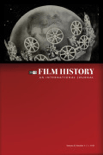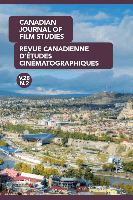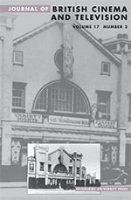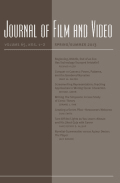
SIGHT AND SOUND
Scope & Guideline
Engaging Minds Through the Lens of Film
Introduction
Aims and Scopes
- Cinematic Analysis and Criticism:
The journal regularly publishes in-depth analyses of films and television shows, offering critical insights into narrative structures, visual aesthetics, and thematic elements. - Cultural Context and History:
Papers often explore the historical and cultural contexts of films, examining how societal changes influence cinematic narratives and representations. - Diversity and Representation:
A key focus is placed on the representation of marginalized groups in cinema, addressing issues of race, gender, and sexuality within film and television. - Film Theory and Philosophy:
The journal engages with various theoretical frameworks and philosophical inquiries related to film, including auteur theory, genre studies, and the impact of technology on filmmaking. - Industry Insights:
Contributions frequently include discussions about the film industry, including production practices, distribution, and the evolving landscape of film criticism in the digital age.
Trending and Emerging
- Exploration of New Media and Formats:
There is an increasing interest in how new media platforms, including streaming services and virtual reality, are reshaping cinematic experiences and audience engagement. - Intersectionality in Film Studies:
Papers are increasingly focusing on intersectional analyses that consider how various identities interact within cinematic narratives, enhancing discussions around representation. - Impact of Global Events on Cinema:
The journal is seeing a rise in articles that analyze how global events, such as the COVID-19 pandemic and social movements, influence film production and thematic content. - Emerging Filmmakers and Voices:
A trend towards highlighting the works of emerging filmmakers from diverse backgrounds is evident, reflecting a commitment to amplifying underrepresented voices in the industry. - Environmental and Social Justice Themes:
There is a growing body of work addressing environmental issues and social justice narratives within film, indicating a shift towards films that engage with contemporary global challenges.
Declining or Waning
- Traditional Film Criticism:
There appears to be a noticeable decline in conventional film reviews in favor of more analytical and thematic explorations of films, indicating a shift towards deeper critical engagement. - Mainstream Hollywood Focus:
Articles centered on mainstream Hollywood productions have become less frequent, as the journal increasingly emphasizes independent and international cinema. - Nostalgic Retrospectives:
Papers that primarily focus on nostalgic retrospectives of classic films are waning, as contemporary issues and current cinematic trends take precedence in scholarly discussions.
Similar Journals

POSITIF
Exploring the Intersection of Visual and Performing ArtsPOSITIF is a distinguished journal, published by POSITIF EDITIONS, focusing on the dynamic fields of Visual Arts and Performing Arts. With ISSN 0048-4911, this journal has been a significant contributor to the arts community since its establishment in 2002, and it continues to captivate readers with its upcoming issues projected until 2024. Based in the heart of France at 12 RUE PIERRE ET MARIE CURIE, 75005 PARIS, POSITIF serves as an invaluable platform for researchers, professionals, and students alike, promoting innovative discourse and critical analysis within the arts. Despite holding a Q4 category ranking in the 2023 classification and a Scopus rank of 637/667, its commitment to enhancing the understanding and appreciation of visual and performing arts remains steadfast. Researchers are invited to contribute to this growing body of knowledge, enriching the journal's scope and impact in a vibrant artistic landscape.

FILM CRITICISM
Connecting Scholars to the World of FilmFILM CRITICISM is a prestigious open-access journal dedicated to the study and review of cinema, offering a platform for scholars, critics, and students to engage deeply with the evolving landscape of film. Published by Film Criticism and based in the United States at Allegheny College, this journal has been contributing to film studies since 2002, with recent issues spanning from 2023 to 2024. Registered under ISSN 0163-5069, it is recognized in the Visual Arts and Performing Arts categories, achieving a commendable rank of #372 out of 667 in Scopus, placing it in the 44th percentile of its field. With an open-access policy implemented since 2016, FILM CRITICISM not only broadens accessibility to scholarly work but also enhances the dialogue around cinematic narratives, theories, and critiques. The journal's relevance is underscored by its current Q3 ranking, making it an essential resource for researchers and professionals alike who are invested in the critical examination of film.

CINEFORUM
Exploring the Intersection of Cinema and PerformanceCINEFORUM is a distinguished journal published by the FEDERAZIONE ITALIANA CINEFORUM, focusing on the vibrant field of Visual Arts and Performing Arts. With an ISSN of 0009-7039, this journal serves as a significant platform for researchers and practitioners interested in critical discussions and analyses pertaining to cinema and performance. Although coverage in Scopus discontinued in 2020, CINEFORUM has established its standing with a category ranking in the Q4 quartile for Visual Arts, reflecting its niche yet passionate readership in the arts community. Based in Bergamo, Italy, the journal aims to foster a deeper understanding of cinematic and performative texts, offering insights and scholarly contributions that enhance the discourse within these artistic domains. Catering to an audience that includes researchers, professionals, and students, CINEFORUM remains an essential resource for those looking to explore the intersection of theory and practice in cinema and performing arts.

Studi Pasoliniani-Rivista Internazionale
Diving into the Rich Tapestry of Pasolini's WorksStudi Pasoliniani-Rivista Internazionale is a distinguished academic journal dedicated to the exploration of the works and influence of Pier Paolo Pasolini, an eminent figure in Italian literature and cinema. Published by Fabrizio Serra Editore in Italy, this journal adheres to a multidisciplinary approach that encompasses critical analyses in linguistics, literature, and literary theory, making it a valuable resource for researchers and scholars seeking to deepen their understanding of Pasolini's legacy. Currently, Studi Pasoliniani holds a Q4 quartile ranking in both Linguistics and Language and Literature and Literary Theory, reflecting its commitment to fostering scholarly discourse within these fields. Although the journal does not operate under an open access model, its publication from 2019 to 2023 assures that its content remains relevant and beneficial for academic inquiry. Researchers, professionals, and students alike will find this journal an indispensable venue for engaging with contemporary interpretations and critiques of Pasolini's oeuvre, amidst the rich cultural and historical contexts that inform his work.

Film History
Unveiling the cinematic narratives that shape our world.Film History, published by Indiana University Press, is a premier academic journal that delves into the evolving landscape of cinema, illuminating the intricate interplay between historical narratives and film culture. With ISSN 0892-2160, and E-ISSN 1553-3905, this journal has established itself as a crucial resource for researchers, professionals, and students in the fields of history and visual arts. Recognized in the Q2 category for both History and Visual Arts and Performing Arts as of 2023, it boasts impressive Scopus rankings, securing #152 out of 667 in Visual Arts and Performing Arts, and #524 out of 1760 in History, placing it in the top 30th percentile. Although it does not currently offer open access options, the journal provides a wealth of scholarly articles that critically engage with film as a historical text, fostering a deeper understanding of its role in shaping societal narratives. Since its inception in 1987, Film History has been at the forefront of academic discourse, making it an invaluable resource for those seeking to explore the rich tapestry of cinematic history.

Hrvatski Filmski Ljetopis
Analyzing the Rich Tapestry of Croatian Cinema.Hrvatski Filmski Ljetopis, published by the Croatian Film Clubs Association, serves as a pivotal academic journal in the field of film studies, celebrating and analyzing the rich cinematic heritage of Croatia and beyond. With an ISSN of 1330-7665, this journal caters to researchers, practitioners, and students who are passionate about the art of filmmaking, encompassing both theoretical discourse and practical implications. Although it is not currently available as an open-access publication, its curated content is of significant value to anyone interested in the evolution, critique, and history of film in a Croatian context, having previously been indexed in Scopus until coverage was discontinued. The journal operates out of Zagreb, Croatia, at the Croatian Film Clubs Association headquarters, and aims to foster scholarly dialogue while contributing to the broader field of national and international cinematography.

Canadian Journal of Film Studies-Revue Canadienne d Etudes Cinematographiques
Unveiling the Artistry of Film StudiesCanadian Journal of Film Studies-Revue Canadienne d'Études Cinématographiques is a distinguished publication dedicated to the exploration of film studies within the context of Canadian cinema and global visual arts. Published by University of Toronto Press Inc., this journal offers a platform for innovative and critical scholarship, having achieved a notable Q2 ranking in the Visual Arts and Performing Arts category for 2023, with an impressive Scopus rank of 207 out of 667, positioning it in the 68th percentile among peers. With a continuous publication record since its established years from 1998 to 2001 and 2004 to 2024, it has become an essential resource for researchers, professionals, and students interested in the evolving landscape of film and cinema. The journal not only addresses theoretical perspectives but also engages with contemporary practices, thereby fostering a deeper understanding of cinematic arts. Despite not offering open access, it remains a vital repository of knowledge for those seeking to advance their studies and contribute to the discourse in film studies.

Journal of British Cinema and Television
Charting the Evolution of British Cinema and TelevisionJournal of British Cinema and Television, published by Edinburgh University Press, is a leading academic journal that explores the dynamic interplay between British cinema and television within the context of cultural studies. With an ISSN of 1743-4521 and E-ISSN of 1755-1714, this journal provides a platform for scholarly discourse, enabling researchers, professionals, and students to engage with critical analyses of screen media and its socio-political impact. As a Q3 journal in Communication and a Q1 journal in Visual Arts and Performing Arts for 2023, it occupies an influential position, particularly in the Arts and Humanities, where it ranks in the 90th percentile. The journal's scope encompasses a wide range of topics, from historical perspectives to contemporary practices in British visual culture, making it essential reading for anyone interested in the evolution and significance of screen studies in the UK. While it is not an open-access publication, the rigorous peer-review process ensures high academic standards and contributes to its esteemed reputation in the field. As it continues to converge from 2004 to 2024, the Journal of British Cinema and Television remains a vital resource for those seeking to deepen their understanding of British media and its global resonance.

Studies in Eastern European Cinema
Connecting Scholars to the Heart of Eastern European CinemaStudies in Eastern European Cinema is a distinguished journal dedicated to exploring the rich and diverse landscape of cinematic art in Eastern Europe. Published by Routledge Journals, Taylor & Francis Ltd, this journal has carved a unique niche since its inception in 2010, providing insightful analysis and fostering dialogue among scholars, professionals, and students in the fields of Communication and Visual Arts and Performing Arts. With a current impact factor reflected in its respective quartile rankings, which position it in Q4 in Communication and Q2 in Visual Arts and Performing Arts, the journal serves as an essential platform for research and discourse on the cinematic contributions of Eastern Europe. Featuring contributions that analyze historical contexts, artistic trends, and cultural implications, it aims to broaden the understanding of Eastern European cinema's role within the global film landscape. While it offers a traditional subscription model, its ongoing commitment from 2010 to 2024 ensures it remains at the forefront of academic inquiries, appealing to a growing audience dedicated to the appreciation and scholarship of Eastern European cinematic arts.

JOURNAL OF FILM AND VIDEO
Exploring the Artistry of Film and VideoThe JOURNAL OF FILM AND VIDEO, published by University of Illinois Press, is a pivotal academic platform that delves into the intricate intersections of film, video, and media studies. With a notable ISSN of 0742-4671 and E-ISSN 1934-6018, this journal has established itself as a significant contributor to the visual arts and performing arts field, currently positioned in Q3 of its category as per the 2023 quartiles. Spanning from 2002 to 2024, it presents a comprehensive array of research, critiques, and theoretical discussions that advance scholarly discourse in film and video. The journal encourages contributions that explore innovative narratives and methodologies, catering to a diverse readership of researchers, professionals, and students alike. While it maintains a traditional subscription model and is not open access, its impact is amplified through its Scopus ranking, holding the 323rd position out of 667 in the visual arts and performing arts category. With its commitment to fostering critical conversations and promoting scholarly excellence, the JOURNAL OF FILM AND VIDEO remains an essential resource for those invested in the study and understanding of film and media.